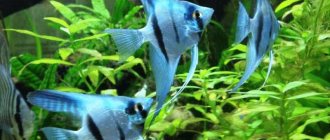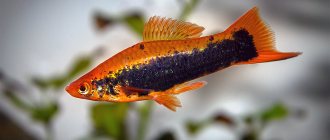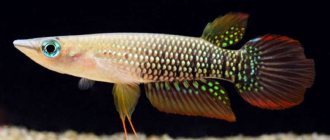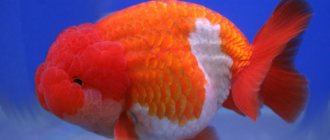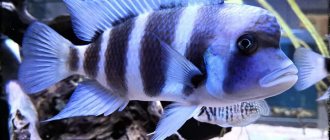Description of the fish
All labeos have a vague resemblance to sharks , however, the color features will vary depending on whether they belong to a particular species.
Appearance
Labeo has an elongated, slender body, somewhat flattened laterally, vaguely reminiscent of a torpedo. The back of the fish is curved and decorated with a high “shark” fin.
Body color depends on the species of a particular specimen , but it is usually uniform throughout the body, only the color of the two-lobed tail may differ.
The head is small, with rather large, slightly protruding eyes. Lower mouth, adapted for scraping algae. The labeo has large lips and its mouth is decorated with a pair of whiskers on the sides.
The lifespan of a fish with proper care is about 6 years, during which time the body length can reach 15 cm.
Interesting! Female labeos are slightly larger than males, but have a duller coloration.
Area
The natural range extends to the countries of Southeast Asia. Fish prefer shallow water bodies, whose maximum depth is about a meter, with a sandy or rocky bottom.
When spawning time comes (it falls during the rainy season), the fish are able to overcome considerable distances to flooded floodplains , but due to the construction of dams and drainage of swamps, many of their migration routes were simply destroyed.
Naturally, this plight affected the number of labeos in nature.
In natural habitats there were labeos whose dimensions exceeded 30 cm.
Lifestyle
Labeos are predominantly nocturnal . Young fish tend to flock together in schools, but with age they lose the need for company. Adults are found only for reproduction.
Labeos attract the attention of aquarium enthusiasts with their unique swimming style: the fish can stay strictly vertical without any visible effort, swim upside down, moving its fins , and even crawl along the bottom of the aquarium on its fins.
Features of behavior
Labeo representatives monitor the boundaries of their territory quite clearly. Therefore, neighbors in a pond need to be selected carefully . Adult fish prefer solitude, avoiding companies.
Lifespan
Labeos are long-lived. With proper care, the fish will live in an aquarium for at least 6 years , but there are cases where some individuals lived much longer than 10 years.
Motherland
The labeo fish (family Cyprinidae) is found in Southeast Asia. Habitats are small streams, lakes and rivers with strong currents, densely overgrown with vegetation. Under natural conditions, the size of the labeo reaches 30 cm. The fish was first discovered in the floodplain of the Chaopraya River in the Kingdom of Thailand, in 1952 it was brought to Europe, and in 1957 it appeared among Soviet aquarists. Later, species were discovered living in Africa, where they are natural orderlies.
Labeos are omnivores, but prefer plant foods. During spawning (coinciding with the rainy season), the fish makes long migrations. Land drainage and dam construction have disrupted the labeo's life cycle, significantly reducing its population.
Types of labeo with photos
You can find such fish in home ponds.
Labeo bicolor or two-color (Epalzeorhynchos bicolor)
A representative of Thai reservoirs came to Russia in 1959 and quickly attracted the attention of aquarists.
Its contrasting color (velvet black body and bright red tail) leaves no one indifferent. The fins have a translucent appearance.
Green (Epalzeorhynchos frenatus)
It is distinguished by a beautiful olive body color with a golden tint. The abdomen has a clear silvery tint, the fins have a reddish tint.
Albino
Elongated and more graceful, in comparison with other labeos, the body of the albino is colored in a light tone with a pink tint. At the same time, the eyes and fins have a reddish tint.
Black (Morulius chrisophecadion)
Also known as morulis. It is distinguished by beautiful black scales with a brown (less often blue) tint.
Young fish have a gray or silver, rather light color. The black labeo is distinguished from the two-color labeo by its completely black color. The fins are the same shade as the body.
Harlequin
This species of labeo lives in the waters of Africa. It has the property of changing color as it matures.
Thus, juveniles are beige in color, but have brown spots along the body and fins. Adult specimens are gray.
Interesting! The size of this fish can reach 30 cm.
Diseases
The bicolor labeo is an aquarium fish with high immunity. The main reason for her poor health is errors in care. The fish does not tolerate long-term stress that arises due to disturbances in maintenance:
- at low water temperatures;
- low compressor power;
- poor quality nutrition.
The labeo appears depressed, its color turns pale, and its appetite disappears. The fish react negatively to the movement of their shelter during cleaning. When populating the aquarium, the labeos are introduced first, allowed to get comfortable, then the rest of the fish are placed.
04:19
LABEO. MAINTENANCE, CARE, FEEDING, REPRODUCTION, COMPATIBILITY.
06:18
Cure for fish for all diseases (practically)
06:23
Treatment of aquarium fish with salt for semolina and other diseases.
Diseases that may appear during aquarium keeping:
- ichthyophthyriosis is a highly contagious disease, manifested by the appearance of white spots on the body and fins, and exhaustion;
- dropsy (carp rubella) - there is bloating, redness of the abdomen, ulcerations, loss of appetite;
- mucous skin - manifests itself as a whitish coating on the body, occurs with a bacterial or parasitic infection.
Sick fish are placed in quarantine and treated in a saline solution (1 tbsp per 10 liters of water). For dropsy, antimicrobial drugs are added to the feed.
Early diagnosis of diseases increases the chances of recovery.
Maintenance and care
Labeo cannot be called easy to care for and maintain: the fish is more suitable for experienced aquarists than for beginners .
Water requirements
The fish requires a spacious aquarium with a volume of at least 60 liters . Many aquarists even believe that to comfortably keep one individual, you will need a reservoir with a capacity of at least 80 liters.
The optimal water temperature is 23…27 °C with a hardness of 6–18 gH and acidity of 6.5–7.5 pH .
In their natural environment, labeos live in bodies of water with strong currents; similar conditions need to be recreated in the aquarium.
In addition, Labeo requires fresh water , which is provided by weekly water changes of up to 20% of the aquarium volume.
Lighting
Avoid exposure to direct sunlight - this is not only harmful to the microclimate of the reservoir, but also will not delight the fish. They prefer diffused lighting .
Equipment
For the aquarium to function correctly, you will need a powerful filter and a good aeration system .
Interior
To create an interior, try to select dark-colored soil, preferably pebbles, small stones or coarse sand.
Make sure that there are no sharp corners on the stones that could injure the fish. In addition, the aquarium must be equipped with a lid - there are often cases when labeos jump out of the water.
Flora plays a very . Preference should be given to broad-leaved plants with a developed root system that can take root on stones and snags.
The following decorative elements are required when creating a personal territory:
- driftwood;
- large stones;
- decorative amphorae and locks .
Feed
Labeos are omnivorous fish and can eat completely different foods , but they still give preference to plant foods.
You can add chopped greens (cucumbers, zucchini, lettuce) to your fish’s diet. They actively eat microalgae from the walls of the aquarium, but will not refuse balanced food in the form of granules or chips (try to choose those types of food that sink).
Reviews
A two-color labeo appeared in my aquarium and soon became my friend. At first, his behavior bothered me: he could lie on the bottom with his belly up or freeze vertically in the water column. I thought he was sick and would soon die, but the fish did not lose his appetite, it turned out that this was natural swimming for him. Ekaterina, 37 years old, Moscow
When I put my hand into the aquarium, the inquisitive labeo is right there. He gently pinches my hand, lightly tickling me with his antennae. The fish is very emotional: as soon as I bring my hand closer to the snag that he has chosen for his shelter, he suddenly turns pale, it seems that the fish is about to faint. It is very interesting to watch an aquarium labeo: judging by its behavior, the fish’s intelligence is quite high, it strictly controls the boundaries of its territory. Valentin Samoilov, 60 years old, Yaroslavl region.
Before getting an aquarium labeo, I read the literature and purchased a ceramic decoration in the form of an amphora with an entrance and exit. The fish immediately made it its refuge. You can often watch her swim in and out of hiding. Labeo is fast and nimble, makes rapid throws. Unpretentious in nutrition, willingly eats not only plant foods, but also bloodworms and tubifex.Juli88
My big mistake was introducing a pair of veiltails into a common aquarium. Although they were not red, for some reason my two-color labeo actively did not like them. After a couple of hours, the goldfish, with their fins badly torn, had to be urgently transplanted. In relation to other aquarium inhabitants, including snails, my Labeo is quite peaceful. Aquarist20_10
Compatibility with other fish
Young fish can form schools, but since they are quite shy, most of their time among vegetation.
With age, representatives of this family become quite aggressive, and it is not worth keeping more than four individuals in one large reservoir. In this case, the aquarium must have a clear division into zones .
A good neighborhood with Labeo is possible:
- with scalars;
- barbs;
- zebrafish;
- catfish coriadoras;
- tetras;
- swordtails;
- gourami.
Among the bad neighbors the following fish are noted:
- cichlids;
- koi carp;
- astronotuses.
Nutrition
Feeding Labeo at home will not cause any trouble for the aquarist, since most of the diet consists of plant foods, although pets will not refuse live food. The fish are fed with the following products:
- Dry food for herbivores.
- Lettuce, zucchini, cucumbers.
- Egg yolk, seaweed, oatmeal flakes.
When choosing food for pets, you should give preference to the sinking type, since due to the structure of the mouth, fish can only eat from the bottom or from another surface.
Feed morning and evening. If all the food is not eaten within 2 minutes, be sure to remove the leftovers and reduce the portion size.
Fasting days (once a week) will be very useful for Labeo.
Reproduction
Achieving spawning in an artificial reservoir is incredibly difficult, but possible.
Sex difference
It should be noted that it is not possible to distinguish juveniles. Fish acquire sexual differences only upon reaching sexual maturity , which occurs at 1.5–2 years.
A female labeo can be distinguished only by its more rounded abdomen and the straight ascending line of the dorsal and anal fins (in males it is somewhat curved).
Stimulating injections
Since natural spawning in an aquarium is practically impossible, breeders often use hormonal injections that are injected into the backs of females and males .
You can also purchase the drug "Nerestin", which is available in the form of injections and feed additives.
Male shortage
Another difficulty in reproducing the population in captivity is the lack of males. There are initially fewer of them in the litter than females, and they are smaller.
Due to this difference, females often simply slaughter males . There is only one way out in such a situation - to place weak individuals with developmental delays in a separate reservoir.
Preparation for spawning and spawning
To reproduce offspring, a spawning tank with a volume of 150 liters and a water height of about half a meter is prepared. The spawning tank should have enough plants, a good filter and an aeration system. Only diffuse lighting is allowed.
Individuals intended for reproduction must be seated on the eve of the procedure . The water temperature is reduced to 23 °C, and the water is changed daily.
The diet of future parents should be varied and plentiful. For spawning, one female and two or three males .
After the fish have received the drug, they are transplanted into the spawning tank, and spawning begins after 5–6 hours. The spawning process itself takes about half an hour.
Part of the eggs immediately sinks to the bottom area, where the labeos eat it. Unfertilized eggs are whiter and should be removed from the aquarium.
After spawning, the spawners are returned to the main reservoir, and the eggs are transferred to a small aquarium (up to 20 liters) with light aeration.
Attention! The water needs to be updated frequently, because after the eggs hatch, it may become cloudy, which will lead to the death of the fry.
Development of labeo fry
The fry hatch on the second day; they are able to move independently and eat simple organisms .
After a few days, ground egg yolk or brine shrimp eggs are introduced into the fry’s diet. In the first two weeks, almost half of the litter dies. The further development of the fry is extremely heterogeneous.
Lifestyle
They lead a mostly bottom-dwelling lifestyle. They can also live in the water column. Activity develops in the evening.
In addition to the contrasting coloring of the body and fins, the fish are surprising in their ability to stably position themselves in the water in a vertical state, and also with their belly up. This makes it easier for them to eat fouling on the walls of the tank or on the underside of leaves.
They are able to move along the bottom using their pectoral fins or jump out of a body of water.
Able to move along the bottom using pectoral fins
Labeos in nature often act as free cleaners of the surface of hippopotamus skin from various kinds of parasites.
Feeding
Despite the fact that the opinion that Labeo feeds exclusively on plants is recognized as erroneous, the diet of the fish includes periphyton in large quantities. The pet is not picky when choosing food; it accepts dry, live and frozen foods. You can pamper him with bloodworms, tubifex, coretra, and crustaceans. Combined foods include mixtures of cereals and oatmeal in the diet. Sometimes the owners treat the fish with egg yolk and white bread. The pet eats even boiled vegetables with an enviable appetite.
Labeo are peculiar “wolves” of the aquarium; they eat dead individuals, purifying the water from potential contaminants.
Diseases
In fact, these representatives of the underwater kingdom are not prone to frequent illnesses. The causes of aquarium lobeo disease can be: improper care; poor equipment; temperature violation; loss of color brightness.
As soon as the fish shows the first symptoms of the disease, it is immediately quarantined. The liquid is disinfected with an antibiotic. All medications are purchased in specialized stores or from breeders.
Labeo is a beautiful species of fish that will decorate an aquarium and show the excellent taste of the owner. Maintaining them requires responsibility and patience. If you follow all the rules of maintenance and care, then there will be no problems with keeping and breeding Labeo.
Health problems
Adult fish tolerate moderate changes in water parameters well and rarely get sick. But still, the species has some health problems, the most common:
- dropsy or rubella of carp (aeromonosis);
- increased skin mucousness.
In stressful situations, the labeo's color turns pale. Also, the color often changes in the evening, but this is considered normal.
Lobeo fish rarely get sick, but in stressful situations they can turn pale.
Features of behavior
Labeos spend most of their time in the bottom and middle layers of water. Fish are highly active and move quickly. At dusk they feel very confident. Pets are capable of swimming in a variety of body positions, including belly up. They can move along the bottom on pectoral fins, and also take poses that allow them to eat algae even from the undersides of aquatic plants. Descriptions of the behavior of fish often attract novice aquarists who get such pets without taking into account their needs and characteristics.
An interesting fact is that Labeo can be trained to be handled.
The territoriality of fish is pronounced. They protect their pasture areas from representatives of their own species and fish that have a similar body shape and color. Labeos are especially aggressive towards neighbors with bright tails. If the area of the home pond is insufficient, larger individuals can cause severe stress to others with their attacks. To avoid such problems, it is recommended to create partially separated zones in the aquarium, for which plants are best suited. The green walls will separate the fish from each other when eating and will prevent fights.
Albino labeos are much more delicate than bicolor and green ones. Because of this, it is strictly forbidden to combine them. Colored pets will begin to chase albinos, which will lead to their death.
Adviсe
To avoid stressful situations, it is recommended:
- When cleaning the aquarium, do not suddenly move the pet’s shelter;
- add the labeo to an already equipped aquarium with plants and shelters; empty spaces scare him;
- add other fish after the labeo has developed the territory;
- provide food in sufficient quantity so as not to lead to conflicts;
- a fish wounded in a fight should be placed in another tank and kept there until it fully recovers;
- It is better to entrust the Labeo breeding process to professionals.
Aquarium fish Labeo are amazing pets, whose behavior in the aquarium can be observed for hours. Bright and capricious, labeos fiercely defend their territory, and although the reproduction of their wards is difficult, the popularity of these fish is increasing every year.
Breeding aquarium fish
It is difficult to breed Labeo at home. To achieve spawning, they need to be given hormonal injections.
Labeos reach sexual maturity at the age of one year. For spawning you will need a 150 liter aquarium. 40 cm of water is poured into it. 1 female and 2 males are selected. For 10-14 days, the males are kept separately from the female. They are fed protein foods, then a hormone is injected into the back muscles and placed in a spawning tank. Spawning takes place rapidly; within an hour, the males knock eggs out of the female. The number of eggs can reach 1500. Fish eggs are light.
At the end of spawning, the parents are removed. Weak aeration is left in the spawning tank. The larva appears after 14 hours. The water in the container is changed regularly. On the third day the fry begin to be fed.


